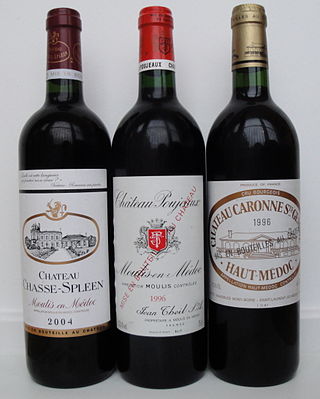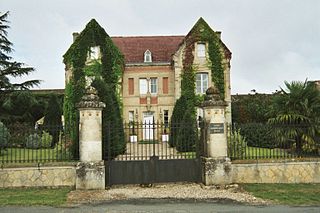Related Research Articles

The Bordeaux Wine Official Classification of 1855 resulted from the 1855 Exposition Universelle de Paris, when Emperor Napoleon III requested a classification system for France's best Bordeaux wines that were to be on display for visitors from around the world. Brokers from the wine industry ranked the wines according to a château's reputation and trading price, which at that time was directly related to quality.
First Growth status is a classification of wines primarily from the Bordeaux region of France.

Graves is an important subregion of the Bordeaux wine region. Graves is situated on the left bank of the Garonne River, in the upstream part of the region, southeast of the city Bordeaux and stretches over 50 kilometres (31 mi). Graves is the only Bordeaux subregion which is famed for all three of Bordeaux' three main wine types—reds, dry whites and sweet wines—although red wines dominate the total production. Graves AOC is also the name of one Appellation d'origine contrôlée (AOC) which covers most, but not all of the Graves subregion.

Pessac-Léognan is a wine growing area and Appellation d'Origine Contrôlée, in the northern part of the Graves region of Bordeaux. Unlike most Bordeaux appellations, Pessac-Léognan is equally famous for both red and (dry) white wines, although red wine is still predominant. It includes the only red-wine producer outside the Haut-Médoc classified in the Bordeaux Wine Official Classification of 1855, the premier cru Château Haut-Brion, and also includes all of the châteaux listed in the 1953/59 classification of Graves. These classed growths account for a third of the wine produced in Pessac-Léognan.

Château Haut-Brion is a French wine estate of Bordeaux wine, rated a Premier Grand Cru Classé, located in Pessac just outside the city of Bordeaux. It differs from the other wines on the list in its geographic location in the north of the wine-growing region of Graves. Of the five first growths, it is the only wine with the Pessac-Léognan appellation and is in some sense the ancestor of a classification that remains the benchmark to this day.

Bordeaux wine is produced in the Bordeaux region of southwest France, around the city of Bordeaux, on the Garonne River. To the north of the city the Dordogne River joins the Garonne forming the broad estuary called the Gironde; the Gironde department, with a total vineyard area of 110,800 hectares, is the largest wine growing area in France.

Château Clos Haut-Peyraguey is a sweet white wine ranked as Premier Cru Classé in the original Bordeaux Wine Official Classification of 1855. Belonging to the Sauternes appellation in Gironde, in the region of Graves, the winery is located in the commune of Bommes. In October 2012 the winery was purchased by French wine tycoon Bernard Magrez.

In 1955, the wines of Saint-Émilion in the wine-growing region of Bordeaux were classified. Unlike the Bordeaux Wine Official Classification of 1855 covering wines from the Médoc and Graves regions, the Saint-Émilion list is updated every 10 years or so. Following the initial classification, the list was updated in 1969, 1986, 1996, 2006, and 2012. However the 2006 classification was declared invalid following a series of legal actions, and the 1996 version of the classification has been reinstated for the vintages from 2006 to 2009.

Pessac is a commune in the Gironde department in Nouvelle-Aquitaine in southwestern France. It is a member of the metropolis of Bordeaux, being the second-largest suburb of Bordeaux and located just southwest of it. Pessac is also home to Bordeaux Montaigne University and the Institut d'études politiques de Bordeaux.
Michel Rolland is a Bordeaux-based oenologist, with hundreds of clients across 13 countries and influencing wine style around the world. "It is his consultancies outside France that have set him apart from all but a handful of his countrymen." It is frequently addressed that his signature style, which he helps wineries achieve, is fruit-heavy and oak-influenced, a preference shared by influential critic Robert Parker.

Château Haut-Bailly is a Bordeaux wine from the Pessac-Léognan appellation, ranked among the Crus Classés for red wine in the Classification of Graves wine of 1953 and 1959. The winery and vineyards are located south of the city of Bordeaux, in the commune of Léognan.

The Cru Bourgeois classification lists some of the châteaux from the Médoc that were not included in the 1855 Classification of Crus Classés, or Classed Growths. Notionally, Cru Bourgeois is a level below Cru Classé, but still of high quality. Many wine writers consider that there is some overlap in quality between the Classed Growths and the Cru Bourgeois, although also saying that by and large the Classed Growths still represent the best wines.

The wine regions of Bordeaux are a large number of wine growing areas, differing widely in size and sometimes overlapping, which lie within the overarching wine region of Bordeaux, centred on the city of Bordeaux and covering the whole area of the Gironde department of Aquitaine.

Château la Mission Haut-Brion is a Bordeaux wine from the Pessac-Léognan appellation, classed among the Crus Classés in the Graves classification of 1953. La Mission Haut-Brion is the sister property of the First Growth Château Haut-Brion. The winery, located in close vicinity of the city of Bordeaux, belongs to the wine region Graves, in the commune of Talence with additional property in Pessac.
Château Laville Haut-Brion was a Bordeaux dry white wine from the Pessac-Léognan appellation, which was ranked among the Crus Classés in the Classification of Graves wine of 1953. The estate is located in close vicinity of the city of Bordeaux, in the commune of Talence.

The wines of Graves in the wine-growing region of Bordeaux were classified in 1953 by a jury appointed by Institute National des Appellations d'Origine, and approved by the Minister of Agriculture in August of that year. The selection was revised with a few additions in February 1959. The classification concerns both red and white wines, and all chateaux belong to the appellation Pessac-Léognan, which eventually came into effect on September 9, 1987.
Château Romer is a sweet white wine ranked as Second Cru Classé in the original Bordeaux Wine Official Classification of 1855. Belonging to the Sauternes appellation in Gironde, in the region of Graves, the estate is located in the commune of Fargues de Langon.
Château Pape Clément is a Bordeaux wine from the Pessac-Léognan appellation, ranked among the Crus Classés for red wine in the Classification of Graves wine of 1959. It is the oldest wine estate in Bordeaux, harvesting its 700th vintage in 2006. The winery and vineyards are located in the commune of Pessac, south-west of the city of Bordeaux. When the estate was omitted from the initial Graves classification of 1953 it caused some controversy.
Château Brown is a Bordeaux wine from the Pessac-Léognan appellation, unranked in the Classification of Graves wine. The winery and vineyards are located south of the city of Bordeaux, just north of Château Olivier with property within the communes of Gradignan, Villenave-d'Ornon and Léognan.

Château Raymond-Lafon is an unclassified Sauternes wine producer from the Sauternes appellation. The estate's sweet wines are a result of the onset of "noble rot".
References
- ↑ "Bernard Magrez buys Château Le Sartre - Decanter". Decanter. 2017-12-15. Retrieved 2018-02-22.
- ↑ Bloomberg.com (August 8, 2005). Bordeaux Mogul Sells Cult Wines Under Global Brand: Elin McCoy
- ↑ Franc, Mitch Wine Spectator (March 14, 2008). "French Wine Tycoon Magrez Moves into Chile". Archived from the original on October 15, 2008. Retrieved January 10, 2009.
- ↑ Anson, Jane, Decanter.com (December 30, 2008). "Chateau Latour for sale".
- ↑ Decanter (July 2009). "The Power List", p.35
- ↑ Lechmere, Adam, Decanter.com (June 1, 2009). "Power List 2009: Parker Gives Way to Constellation".
- ↑ Anson, Jane, Decanter.com (April 19, 2012). "Bernard Magrez buys three Bordeaux estates".
- ↑ Wine Spectator Home | Wine Spectator